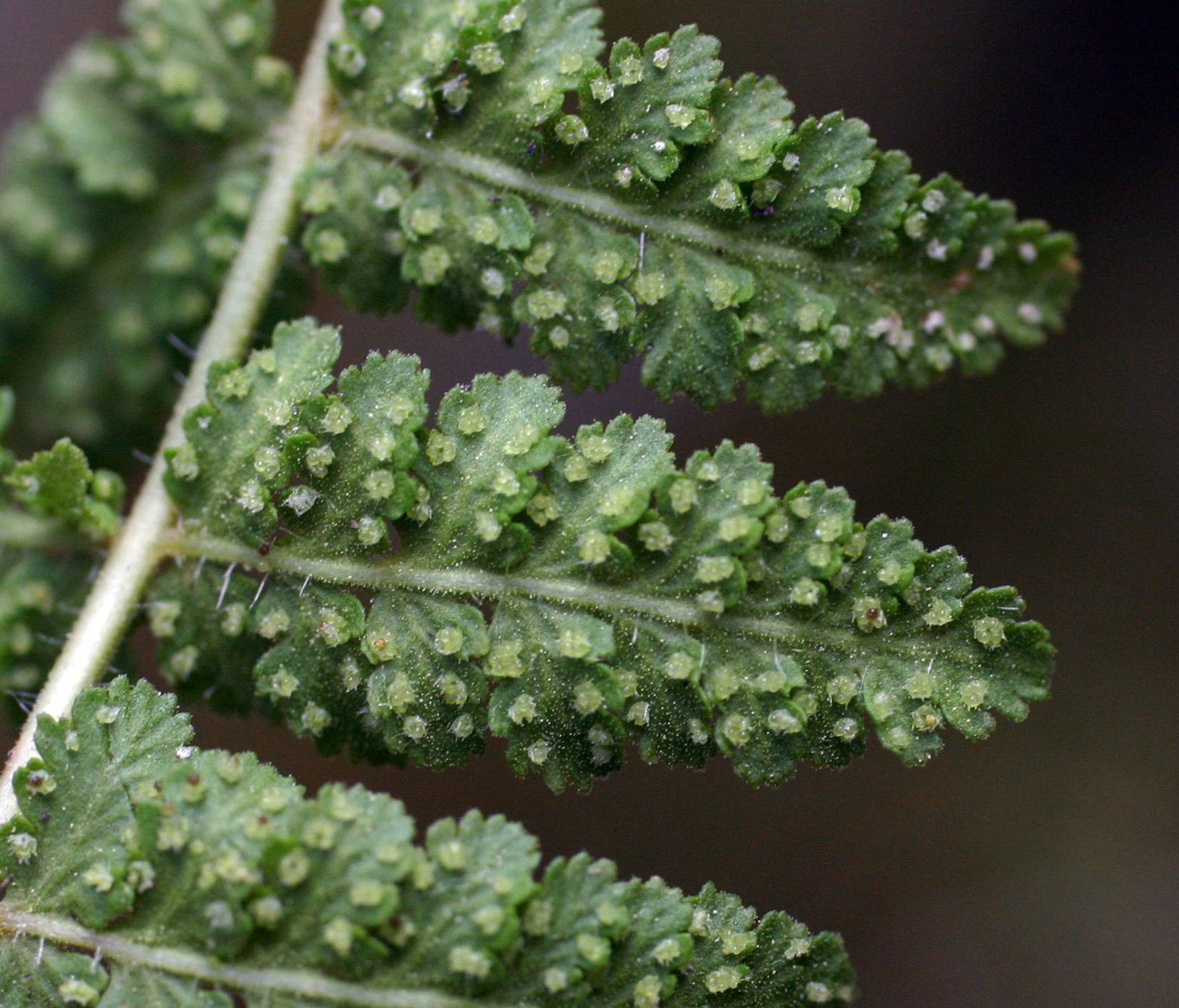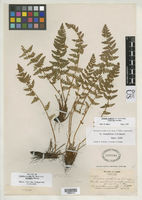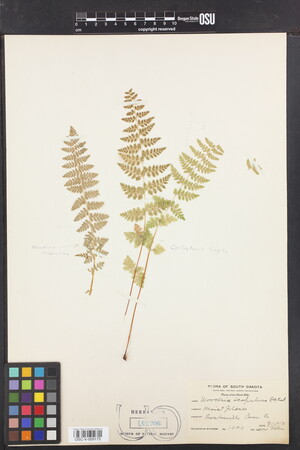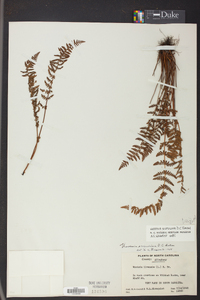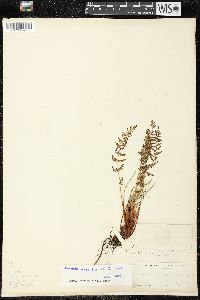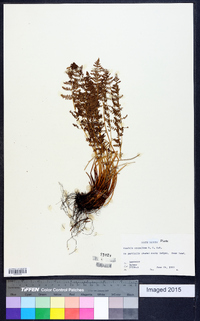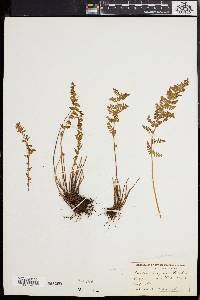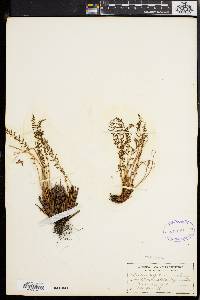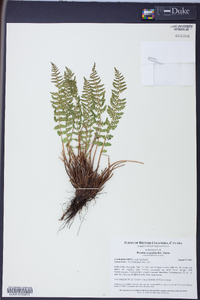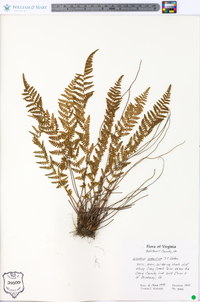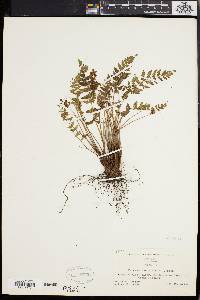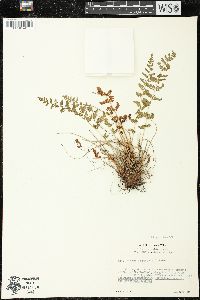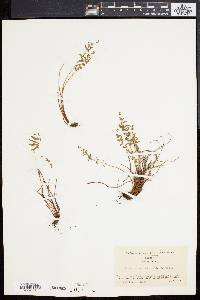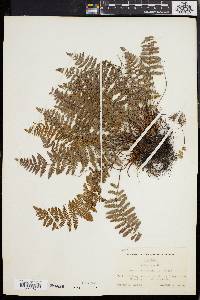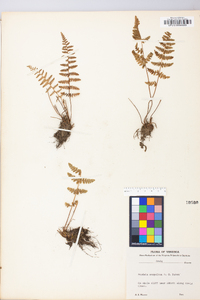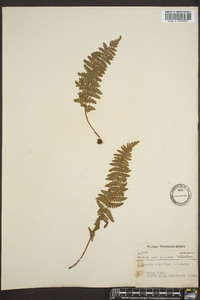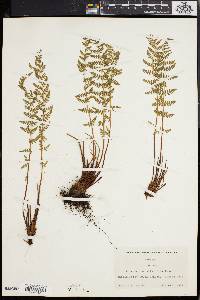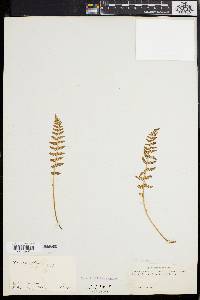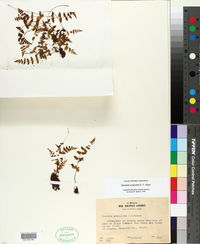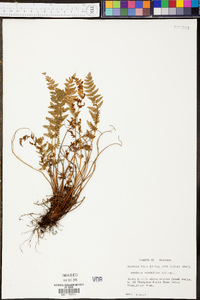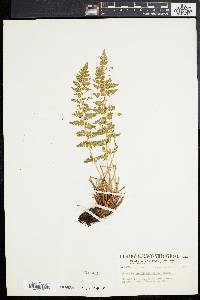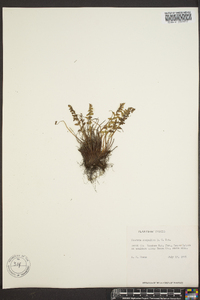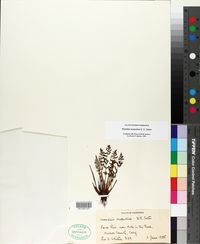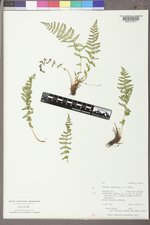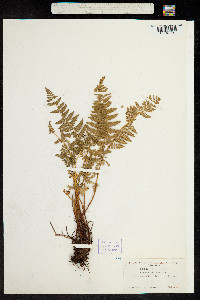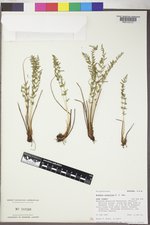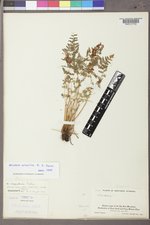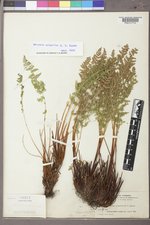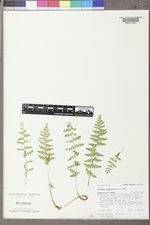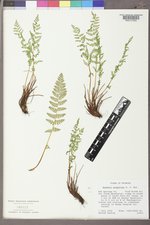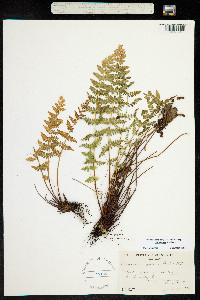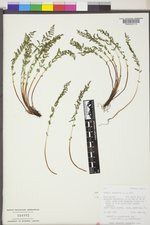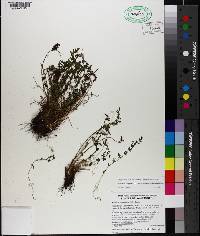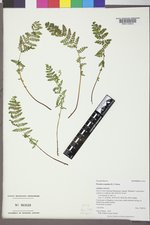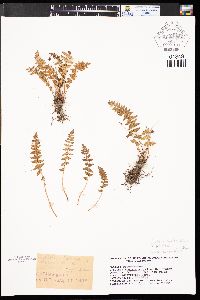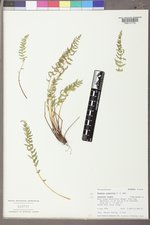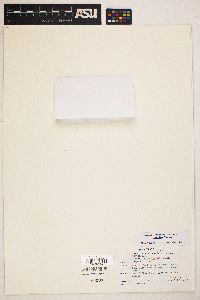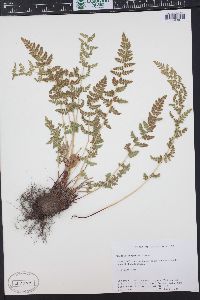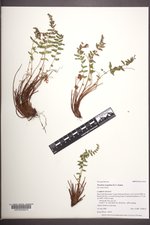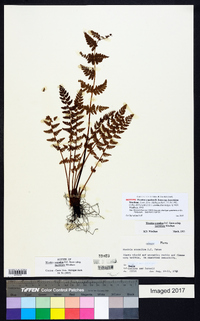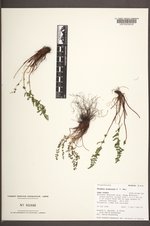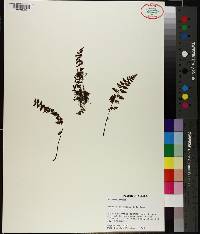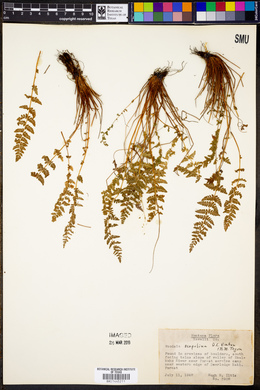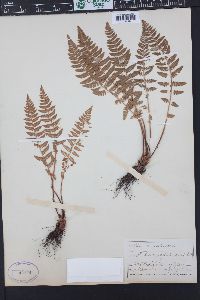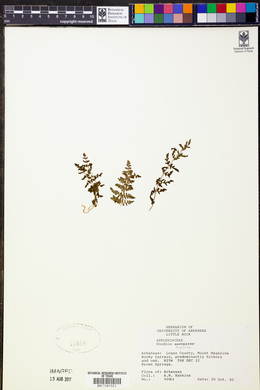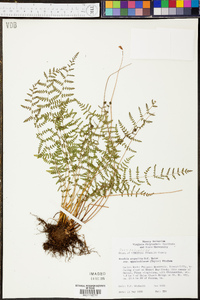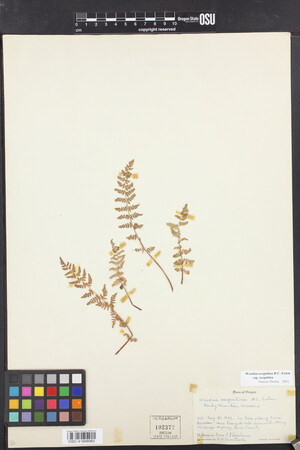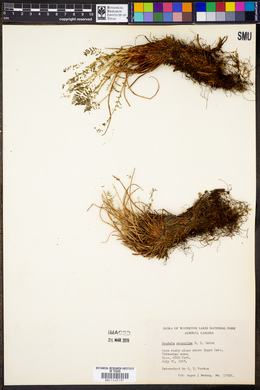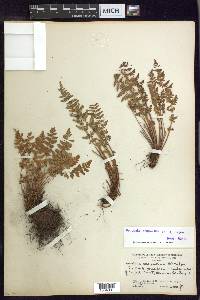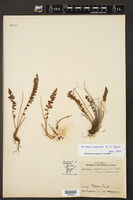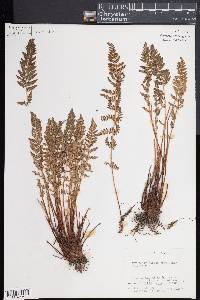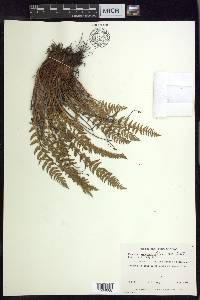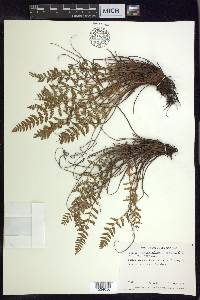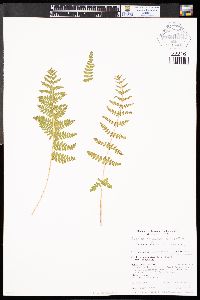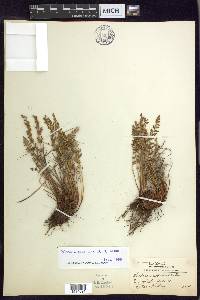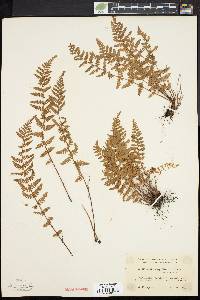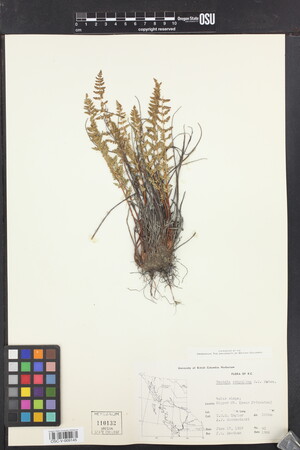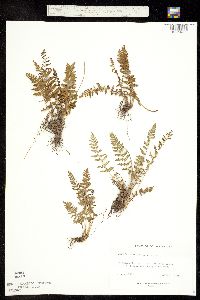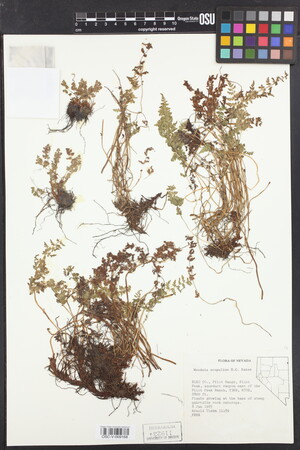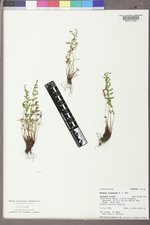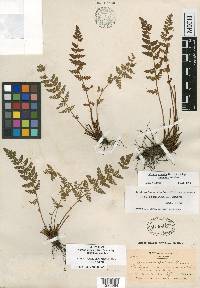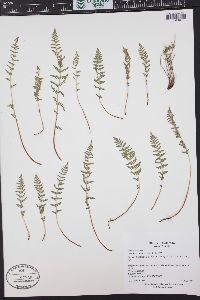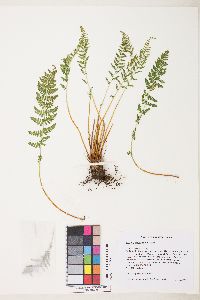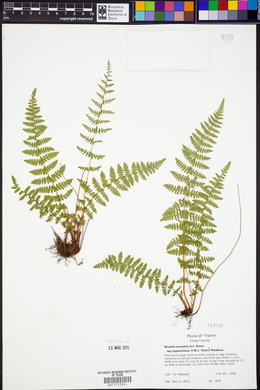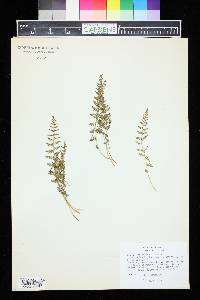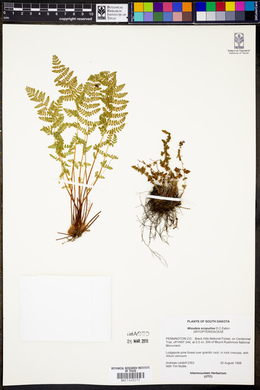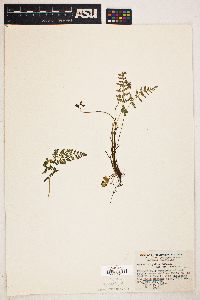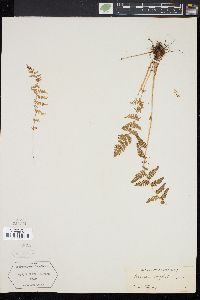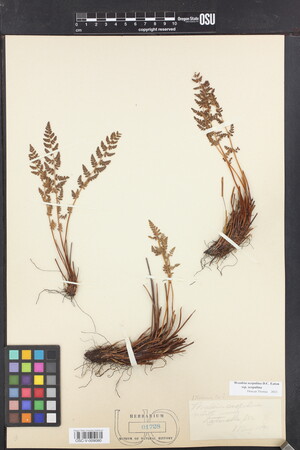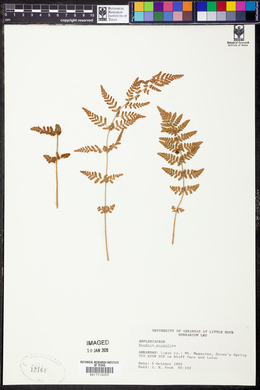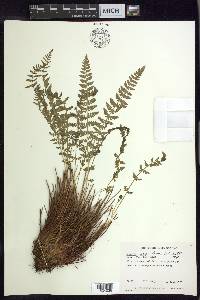
|
|
|
|
Family: Woodsiaceae
Rocky Mountain Cliff Fern, more...Rocky Mountain woodsia
|
Stems compact, erect to ascending, with few to many persistent petiole bases of unequal lengths; scales uniformly brown or bicolored with dark central stripe and pale brown margins, ovate to narrowly lanceolate. Leaves 9--35 × 1--8 cm. Petiole usually reddish brown to dark purple proximally when mature, not articulate above base, relatively brittle and easily shattered. Blade lanceolate to linear-lanceolate, 2-pinnate proximally, moderately glandular, rarely somewhat viscid; most glandular hairs with thick stalks and distinctly bulbous tips; rachis usually with abundant glandular and nonglandular hairs. Pinnae lanceolate-deltate to ovate, longer than wide, abruptly tapered to a rounded or broadly acute apex, occasionally attenuate; largest pinnae with 5--14 pairs of pinnules; abaxial and adaxial surfaces glandular and sparsely villous, with flattened, multicellular hairs concentrated along midribs. Pinnules dentate, often shallowly lobed; margins nonlustrous, thin, slightly glandular and occasionally ciliate with isolated, multicellular hairs, lacking translucent projections. Vein tips slightly (if at all) enlarged, barely visible adaxially. Indusia of filamentous or nonfilamentous segments, these multiseriate proximally, often uniseriate distally, composed of ± isodiametric cells, concealed by or slightly surpassing mature sporangia. Spores averaging 39--57 µm. Woodsia scopulina shows substantial variation in leaf size, shape, and dissection, and in the abundance of multicellular hairs on the pinnae. Although much of this variation seems to be environmentally induced, recent studies (M. D. Windham 1993) have identified three chromosomal/morphologic variants that are treated here as subspecies. Diploid populations of W . scopulina are divisible into two groups, one of which (subsp. scopulina ) is scattered throughout the mountainous regions of western North America while the other (subsp. appalachiana ) is confined to montane habitats in the southeastern United States. These taxa seem amply distinct (T. M. C. Taylor 1947) and might be considered separate species if not for the existence of populations in the Great Lakes region and western cordillera that tend to bridge the morphologic and geographic gap between them. These intermediate populations (subsp. laurentiana ) appear to be uniformly tetraploid and may have arisen through ancient hybridization between subsp. scopulina and subsp. appalachiana . In regions where subsp. laurentiana is sympatric with subsp. scopulina , the two taxa are rarely found growing together, suggesting that they differ in their ecological tolerances and/or habitat requirements.
General: Perennial ferns, stems compact, erect to ascending, the fronds short and clustered, with few to many persistent petiole bases of unequal lengths, plants with short, erect, scaly rhizomes, the scales ovate to narrowly lanceolate, lattice-like, subdenticulate, uniformly brown or bicolored with a dark central stripe and pale brown margins. Leaves: Blades bright green when fresh, lanceolate to linear-lanceolate in outline, pinnasect with alternate segments, uniform, membranaceous, slightly reduced at the base, scaleless but with with long hairs on the midribs and underneath, blades 2-pinnate proximally, 9-35 cm long and 1-8 cm wide, pinnae lanceolate-deltate to ovate and longer than wide, abruptly tapering to a rounded or broadly acute apex, occasionally attenuate, largest pinnae with 5-14 pairs of pinnules, the margins dentate and often shallowly lobed, nonlustrous, thin, slightly glandular and occasionally ciliate with isolated, multicellular hairs lacking translucent projections, vein tips slightly (if at all) enlarged, barely visible above, generally alike, abaxial and adaxial surfaces glandular and sparsely villous, hairs multicellular, glandular, and flattened with thick stalks and distinctly bulbous tips, concentrated along midribs, stipes firm or fleshy and easily crushed, the bases darker or not, the rachis ribbed and grooved adaxially, usually with abundant glandular and nonglandular hairs, petioles reddish brown to dark purple proximally. Sporangia: Sporangia of many segmented hair- or scale-like fragments or lobes encircling the sorus from below, often of crusty, whitish beads, these often becoming obscure with age, indusium of narrow scale-like lobes. Ecology: Found in soil or rock crevices from 4,500-11,500 ft (1372-3505 m). Notes: FNA has divided this species into 3 subspecies, and notes that; "Woodsia scopulina shows substantial variation in leaf size, shape, and dissection, and in the abundance of multicellular hairs on the pinnae." The keys to this species are the fronds with long, articulate, many-celled hairs on the midribs and beneath. Ethnobotany: Ferns considered to be a sign of water when travelling through the mountains. Etymology: Woodsia is after Joseph Woods (1776-1864), English architect and botanical author, and scopulina means growing in rocky places. Sources: FNA 1993, Jepson 2012, Kearney and Peebles 1969 FNA 1993, Jepson 2012, Kearney and Peebles 1969 Common Name: Rocky Mountain woodsia General: Perennial ferns, stems compact, erect to ascending, the fronds short and clustered, with few to many persistent petiole bases of unequal lengths, plants with short, erect, scaly rhizomes, the scales ovate to narrowly lanceolate, lattice-like, subdenticulate, uniformly brown or bicolored with a dark central stripe and pale brown margins. Leaves: Blades bright green when fresh, lanceolate to linear-lanceolate in outline, pinnasect with alternate segments, uniform, membranaceous, slightly reduced at the base, scaleless but with with long hairs on the midribs and underneath, blades 2-pinnate proximally, 9-35 cm long and 1-8 cm wide, pinnae lanceolate-deltate to ovate and longer than wide, abruptly tapering to a rounded or broadly acute apex, occasionally attenuate, largest pinnae with 5-14 pairs of pinnules, the margins dentate and often shallowly lobed, nonlustrous, thin, slightly glandular and occasionally ciliate with isolated, multicellular hairs lacking translucent projections, vein tips slightly (if at all) enlarged, barely visible above, generally alike, abaxial and adaxial surfaces glandular and sparsely villous, hairs multicellular, glandular, and flattened with thick stalks and distinctly bulbous tips, concentrated along midribs, stipes firm or fleshy and easily crushed, the bases darker or not, the rachis ribbed and grooved adaxially, usually with abundant glandular and nonglandular hairs, petioles reddish brown to dark purple proximally. Sporangia: Sporangia of many segmented hair- or scale-like fragments or lobes encircling the sorus from below, often of crusty, whitish beads, these often becoming obscure with age, indusium of narrow scale-like lobes. Ecology: Found in soil or rock crevices from 4,500-11,500 ft (1372-3505 m). Ethnobotany: Ferns considered to be a sign of water when traveling through the mountains. Etymology: Woodsia is after Joseph Woods (1776-1864), English architect and botanical author, and scopulina means growing in rocky places. Synonyms: None Editor: LCrumbacher2012 Rhizome-scales lanceolate, 4-5 mm, hair-pointed, subdenticulate, sparsely ciliate, with an irregular black midstripe; lvs 18-40 cm, evidently stipitate-glandular (the glands clavate) and sparsely to copiously beset with ±elongate, flattened, septate white hairs at least on the rachis and the lower surface of the blade; petiole brown, hairy, scaly only at the base, not articulate; blade lance-linear, 3-7 cm wide, acute, slightly narrowed below, bipinnate, the rachis not scaly; pinnae 9-25 pairs, deltoid-ovate to lanceolate, acuminate, sessile, scaleless, the pinnules 7-10 pairs, oblong, obtuse, crenate to subpinnatifid; indusial segments 3-6, incurved, several cells wide at least below, deeply lacerate; 2n=76. Cliffs and rocky slopes; cordilleran region from Alta. and s. Alas. to Calif. and N.M., e. irregularly to Que.; isolated in the Ozark Mts. and in the s. Appalachian Mts. from Va. and W.Va. to N.C. and Tenn. (W. appalachiana, the Appalachian and Ozarkian plants) W. حaxonii R. M. Tryon is a triploid sterile hybrid with tetraploid W. oregana. Gleason, Henry A. & Cronquist, Arthur J. 1991. Manual of vascular plants of northeastern United States and adjacent Canada. lxxv + 910 pp. ©The New York Botanical Garden. All rights reserved. Used by permission. |
|
|
|
This project was made possible in part by the Institute of Museum and Library Services [MG-70-19-0057-19].
Powered by Symbiota

